Seven Easy Culinary Herbs to Grow in Pots
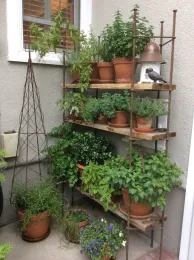
- Having them near a door means they are more accessible when you need a spur-of-the-moment harvest.
- It is easier to provide good soil and drainage in pots.
- You can easily adjust for the watering and light needs of different plants.
- Pots control the growth of herbs—like mint and lemon balm—that like to spread in the garden.
- Attractive pots are a decorative addition to your garden.
We are fortunate to live in a climate that allows for growing a wide variety of herbs. You can start with the ones you like best, but it's also fun to try some that you are not as familiar with. Most are attractive plants in their own right even if you use them in the kitchen only occasionally.
Here is a group of seven easily grown herbs for getting started:
Basil
Sweet basil (Ocimum basilicum)
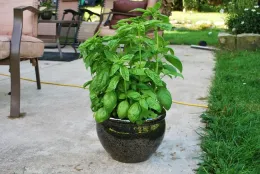
Size: 2'-3' h x w; dwarf varieties (‘Spicy Globe') 8” h x 12” w
Light/Water: Full sun; keep moist, not saturated.
Soil: Loose, porous; pH 4.3-9.1
Harvesting/Pruning: Cut back to just above its second set of leaves when it has 3-5 sets of true leaves. Harvest every week throughout the season.
Notes: There are many varieties beyond the two listed here. It is used in salads and sandwiches, with vegetables, and in pesto. Best used freshly picked but can be dried or frozen. Add to cooked dishes in the last few minutes.
Chives
Common chives, onion chives (Allium schoenoprasum)
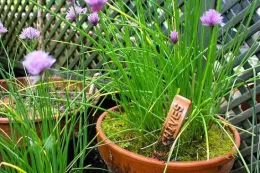
Garlic chives, Chinese chives (Allium tuberosum)
(flattened leaves, white flowers)
Size: 12” to 18” h x w
Light/Water: Full sun to part shade; medium water.
Soil: Well-drained.
Harvesting/Pruning: Harvest the tips once the plants have reached 6” tall, leaving at least 2”.Increases by bulb division; divide every three years. Deadhead before seeds spread.
Notes: Use snipped leaves in uncooked foods or added in the last few minutes to cooked foods. May be frozen. Use garlic chive flowers in the bud stage or freshly opened.
Dill (Anethum graveolens)
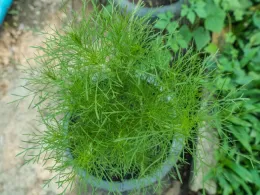
Light/Water: Full sun; keep soil moist but not saturated.
Susceptible to root rot.
Soil: Light to medium texture, well-drained.
Use a pot at least 12” deep to accommodate the tap root.
Harvesting/Pruning: Harvest leaves in the early morning for best flavor and before the flower buds have opened; do not let the plants bolt for a continuous supply. Harvest dill seed at the end of the plant's life cycle when they've started to burn a golden-brown color.
Notes: Fresh dill weed can be stored in the refrigerator for a few days with the stems in a cup of water. It can also be dried. Dry the seeds by hanging the seed heads upside down in a brown paper bag and keeping it in a warm, well ventilated area for two weeks. The seeds or the whole seed heads are used for pickles or added to a variety of dishes. Dill weed leaves are used in soups, stews, meat dishes, pasta ,and egg dishes.
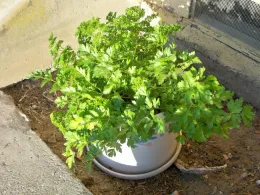
Curly leaf (Petroselinum crispum)
Flat leaf (Italian)(Petroselinum neapolitanum)
Size: 9”-12” h x 9”-12” w
Light/Water: Partial shade to full sun.
Keep moist but not soggy.
Soil: Potting soil mixed with compost.
Harvesting/Pruning: Cut back stalks with young leaves—the most flavorful—to ½”; they will continue to produce more leaves. Parsley is a biennial that us usually grown as an annual. Seeds will develop the second season; the leaves are best the first season.
Notes: Curly leaf parsley is commonly used as a garnish, but flat leaf is a versatile herb that can be used in soups, salads, casseroles, sandwiches, and a variety of other dishes.

Greek oregano (Origanum vulgare subsp. hurtum)
Russian oregano (Origanum vulgare subsp. Gracile)
Sweet marjoram (Origanum majorana)
Size: 1-2' h x 18-24” w
Light/Water: Full sun or part shade; low water once established.
Soil: Dry, rocky, well-drained. Amend with gravel, shells, sand and compost.
Harvesting/Pruning: Cut back in late spring to encourage vegetative growth, and again in midsummer to prevent it from becoming woody. Flavor is best before the plant flowers.
Notes: Many varieties; often mislabeled by nurseries. Leaves and flowers are used in Greek, Italian and French cuisine. Leaves may be refrigerated for 3-4 days or dried.
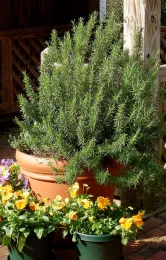
Size: 3'- 4' h x w; smaller in containers.
Trailing varieties will drape over the edge.
Light/Water: Full sun; low water.
Allow soil to dry out between watering to prevent root rot.
Soil: Well-drained with added sand or gravel.
Harvesting/Pruning: Prune to encourage branching,
and remove yellowing or dead leaves and stems. Best time for harvesting is just before blooming.
Notes: A Mediterranean native, rosemary symbolizes remembrance. Its pungent flavor is used to enhance meats, tomatoes, potatoes, eggs and other dishes. May be dried or frozen, although some loss of color will occur.
Sage (Salvia officinalis)
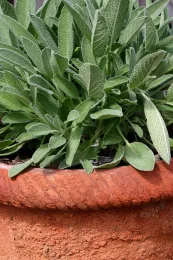
Light/Water: Full sun; avoid intense afternoon sun in hot climates.
Allow soil to dry out between watering once established.
Soil: Well-drained, loamy soilless potting mix is best.
pH 6-7; neutral to slightly acidic.
Harvesting/Pruning: Snip sage early in the morning for best flavor, just above where two leaves meet. Cut back stems by no more than half to encourage new growth. Sage can be propagated by cuttings, division, seeds, and layering.
Notes: Fresh leaves can be stored for 3-4 days in the refrigerator, or the leaves can be dried. Beyond stuffing, sage can be used fresh or dried in a variety of savory dishes, soups, and sandwiches.
If you'd like to go beyond the basics, there are many other interesting and flavorful herbs to choose from, particularly those from international cuisines. You could grow purslane, lemongrass, cilantro, fennel, thyme, winter savory, and many others.
For more information:
Sunset Magazine: Cooking with Fresh Herbs
